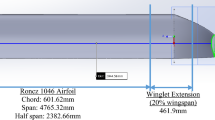Abstract
It is scientifically important science value and engineering promising to develop the buoyancy-lift integrated hybrid airship for high attitude platform. Through the numerical method, a new tandem wings hybrid airship with both higher utility value and economy efficiency was obtained and its total performance and technical parameters were analyzed in detail. In order to further improve the lift-drag characteristics, we implemented the optimization design for aerodynamic configuration of tandem wings hybrid airship via the response surface method. The results indicate that the tandem wings hybrid airship has considerable volume efficiency and higher aerodynamic characteristics. After optimization, the lift-drag ratio of this hybrid airship was increased by 6.08%. In a given gross lift condition, tandem wings hybrid airship may provide more payload and specific productivity. Furthermore, the size of tandem airship is smaller so the demand for skin flexible materials can be reduced. Results of this study could serve as a new approach to designing buoyancy-lifting integrated hybrid airship.
Similar content being viewed by others
Abbreviations
- C d :
-
drag coefficient
- C l :
-
lift coefficient
- D :
-
drag
- e :
-
specific productivity
- h :
-
flight height
- k :
-
lift-drag ratio
- L :
-
length of airship
- L b :
-
buoyancy
- L g :
-
gross lift
- R 2 :
-
multiple correlation coefficient 2 adj
- R 2adj :
-
multiple correlation coefficient corrected
- S :
-
surface of airship
- v :
-
flight speed
- V :
-
volume of airship
- W :
-
dead weight of airship
- W s :
-
weight of skin
- W g :
-
weight of gasbag
- W b :
-
weight of solar battery
- W f :
-
weight of regenerative fuel battery
- W p :
-
payload
- x :
-
axial coordinates
- y :
-
normal coordinates
- %RMSE:
-
average error
- α :
-
angle of attack
- λ :
-
aspect ratio
- µ:
-
power to weight ratio of solar battery
- γ 1 :
-
surface density of skin
- γ 2 :
-
surface density of gasbag
- γ air :
-
air density
- γ he :
-
helium density
- τ :
-
energy density of regenerative fuel battery
- χ :
-
sweep back angle
References
Wang M J, Huang X S. Development of stratospheric airship platform and its key technology analysis. Automat Measur Control, 2007, 26(8): 58–60
Li F, Ye Z Y. The present research situation and future development trend of airship. J East China Jiaotong Univ, 2008, 25(1): 24–27
Ou Y J, Qu W D, Xi Y G. Stratospheric verifying airship modeling and analysis. J Shanghai Jiaotong Univ, 2003, 37(6): 956–960
Gan X H, Guo Y. Introduction to airship technology. Beijing: National Defense Industry Press, 2005. 35–76
Gillett J D. Airship Technology. London: Cambridge Aerospace Series, 1999. 181
Barnard L, Navid L Q, Walter T G. A new concept of hybrid airship. AIAA Paper, 1985, AIAA-85-0868. 153–160
Nagabhushan B L, Tomlinson N P. Flight dynamics analyses and simulation of heavy lift airship. AIAA Paper, 1979, AIAA-79-1593. 74–81
Li F, Ye Z Y. Design and research for a new type buoyancy-lifting row flying-wings. Chin J Theor Appl Mech, 2009, 41(6): 850–857
Body R R. Performance of hybrid air vehicles. AIAA Paper, 2002, AIAA-2002-0388
Liu T S, Liou W W. Aeroship: A new flight platform. AIAA Paper, 2006, AIAA-2006-3922
Patankar S V, Spalding D B. A calculation procedure for heat mass and momentum transfer in three-dimensional parabolic flows. Inc J Heat Mass Tranfer, 1972, 15(2): 1787–1806
Ahn J, Kim H J, Lee D H, et al. Response surface method for airfoil design in transonic flow. J Aircraft, 2001, 38(2): 231–238
Ahn J, Yee k, Lee D H. Tow-point design optimization of transonic airfoil using response surface methodology. AIAA Paper, 1999, AIAA-1999-0403
Venter G, Haftka R T, Starnes Jr J H. Construction of response surfaces of design optimization applications. AIAA Paper, 1996, AIAA-96-4040
Li G, Wang H, Aryasomayajula S R, et al. Two-level optimization of airframe structures using response surface approximation. Struct Multidisc Optim, 2000, 20(2): 116–124
Kim S H, Na S W. Response surface method using vector projected sampling points. Struct Safety, 1997, 19(1): 3–19
Redhe M, Forsberg J, Jansson T, et al. Using the response surface methodology and the d-optimality criterion in crashworthiness related problems. Struct Multdisc Optim, 2002, 24: 185–194
Eguchi K, Yamauchi N, Ocgaki M, et al. Feasibility study program on stratospheric platform airship technology in Japan. AIAA Paper, 1999, AIAA-99-33350
Gang W A. Broadband wireless access system using stratospheric platforms. In: Globecom’00 IEEE Global Conference. Piscataway: IEEE, 2000, 1: 225–230
Zhang Y J, Mao Z Q, Xie X F, et al. Research and application of regenerative fuel cells. Prog Chem, 2006, 18(5): 635–640
Author information
Authors and Affiliations
Corresponding author
Rights and permissions
About this article
Cite this article
Li, F., Ye, Z. & Gao, C. Design of a new tandem wings hybrid airship. Sci. China Phys. Mech. Astron. 55, 1886–1893 (2012). https://doi.org/10.1007/s11433-012-4883-6
Received:
Accepted:
Published:
Issue Date:
DOI: https://doi.org/10.1007/s11433-012-4883-6




